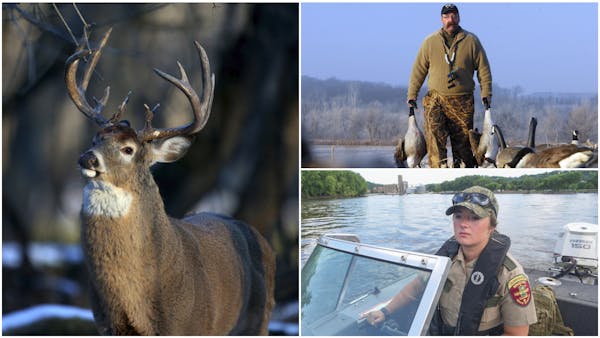As legislators settle into their St. Paul offices to once again squabble over how to distribute the people's money, taxpayers can at least take comfort knowing that $127 million expected to be allocated for fish, game and wildlife habitat will be spent as intended.
The money now rests in the Outdoor Heritage Fund, one of three equal endowments created by the 2008 passage of the Clean Water, Land and Legacy Amendment to the state Constitution. A second fund underwrites clean water, and the third finances parks, trails, arts and cultural heritage.
Recall that the Legacy Amendment, which fractionally increased the state sales tax, was approved by Minnesota voters after hunters, anglers and other supporters had spent 10 years educating, browbeating and cajoling legislators about the amendment's merits. Each of those years ended in frustration as politicians from both parties lined up to deep-six the idea, sometimes in plain sight, sometimes behind closed doors.
The catalyst, ultimately, for the Legislature's willingness to place the proposal on the 2008 ballot was the Rally for Ducks, Wetlands and Clean Water on the Capitol mall in April 2005. Attended by some 6,000 supporters, that gathering was followed by another a year later, also on the mall.
"To organize the rally we formed the largest conservation coalition of hunters, anglers and environmentalists in the state's history — 'guns and greens' we called it," said Dave Zentner of Duluth, who spearheaded the effort. "But we still were unsure whether people would show up. We asked ourselves, 'Is this the Minnesota we think it is?' If it was, the rally, we knew, would succeed."
Critical also to the amendment's eventual passage was the subsequent uniting of conservation groups with supporters of cultural heritage and the arts. This meant passage of the amendment would not only support fish, game, wildlife, clean water, parks and trails, but also arts and cultural groups.
Appealing as the amendment was to a broad cross-section of Minnesotans, many lawmakers acquiesced to its placement on the 2008 ballot only because they thought it would fail. Such a high-profile flop, amendment opponents believed, would stifle future, similar proposals, while strengthening the political hand of agriculture and business groups that had opposed it.
Their bet was Minnesotans might enjoy their natural resources, but they wouldn't tax themselves to pay for additional land and water stewardship — especially not in 2008, on the cusp of a deep nationwide recession.
Some hunters and anglers also were wary. They believed the Legislature in the late 1980s had hoodwinked them by usurping some of the money raised by the state lottery that was supposed to be dedicated to the environment.
To prevent a similar heist of Outdoor Heritage Fund money, a group of hunters and anglers led by Garry Leaf of Sportsmen for Change and retired state Sen. Bob Lessard essentially demanded that a 12-member, citizen-dominated panel — the Lessard-Sams Outdoor Heritage Council — be established in law to review and prioritize expenditures from the heritage fund account.
In an era when government can seem stuck in neutral, or worse, reverse, the exhaustive review of proposed habitat projects by the council is a replication-worthy model — as is the oversight that continues after projects are funded. Detail-laden contracts must be signed with the state, and money is dispensed only on a reimbursement basis.
"We also do random evaluations of projects every year, conducted by outside technical experts," said Mark Johnson, executive director of the Outdoor Heritage Council. "Even the (Department of Natural Resources), when it receives project funds, must prove what they are doing and that they are doing it according to specifications."
Projects the council recommended to the Legislature this session include $6 million for new state wildlife management areas; $8.8 million for grassland enhancement; $4.6 million for forest management; $5.6 million for federal waterfowl production areas; $6 million for shallow lakes and wetlands; and nearly $10 million for small habitat requests from sportsmen's and similar clubs and local governments.
The $8.8 million for grassland enhancement will pay for "roving crews" of habitat developers to travel the state to conduct prescribed burns and other wildlife-land maintenance. The crews' work, overseen by Greg Hoch, DNR prairie habitat team supervisor, is intended "to maintain the fish and wildlife lands we already own."
Multiple fish-habitat projects also are recommended for funding, including, among others, $3.4 million for north-central Minnesota lakes; $3 million for the Sauk River watershed; $2.4 million for trout habitat; $3.8 million for St. Louis River restoration; $900,000 for habitat rehabilitation of the Knife River on the North Shore; $3.2 million for aquatic habitat restoration and enhancement; and $1.4 million for the Fairmont chain of lakes.
Fine-tuning by legislators of council recommendations isn't unusual. But significant changes risk the ire of conservation groups, which so far have successfully turned back such attempts.
Gov. Tim Walz, meanwhile, has pledged to adhere to the council's suggestions.
In coming weeks, while legislators mull the $127 million habitat package, the council likely will undergo membership changes. Four-year terms of citizen members Jane Kingston, Julie Blackburn, Ron Schara and Barry Tilley expire this month, and legislators Rep. Leon Lillie, Rep. Dan Fabian, Sen. Andrew Lang and Sen. David Tomassoni must be reappointed or replaced by their respective chamber leaders.
However these alterations unfold, the amendment's habitat funding model will remain the envy of conservationists nationwide.
Minnesota, as it turned out, was the state that Zentner and other amendment supporters thought it was. Voters overwhelmingly approved the history-changing idea, 56 percent to 39 percent.
Dennis Anderson • 612-673-4424

Anderson: Celebrate Earth Day by rekindling real connection to nature
Anderson: Anglers protesting tough new Mille Lacs rules are wrong

Anderson: Courts, not politicians, should rule on Red Lake, White Earth lands

Anderson: Multimillion windfall gets invasive carp deterrent moving
![A young whitetail deer searches for food as another blanket of snow coats the arrowhead. ] Minnesota -State of Wonders, Arrowhead in Winter BRIAN PETE](https://arc.stimg.co/startribunemedia/WK32UWWY6FKNWJUIYCJ6ZPT4AU.jpg?h=91&w=145&fit=crop&bg=999&crop=faces)

